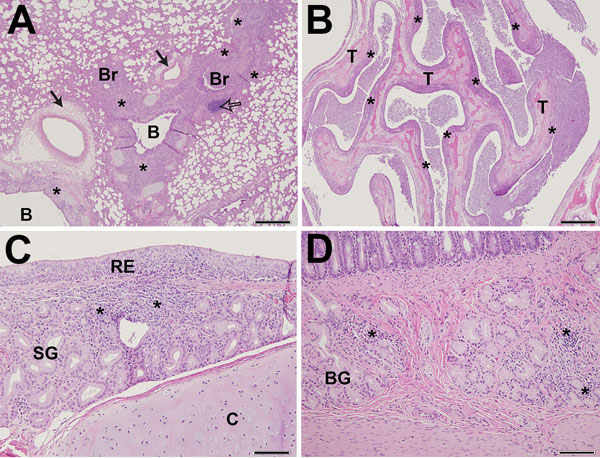Volume 24, Number 1—January 2018
Research
Characterization of a Feline Influenza A(H7N2) Virus
Figure 5

Figure 5. Pathology findings in cats infected with A/feline/NY/16 influenza A(H7N2) virus on day 6 postinfection, New York, NY, USA. A) In lungs, moderately severe histopathologic changes are present in the lower airways. The lamina propria of bronchi (B) and bronchioles (Br) and the surrounding interstitium are infiltrated by numerous histiocytes, lymphocytes, and plasma cells (*), which also extend into and expand neighboring alveolar septa. The infiltrates extend into and expand nearby alveolar septa. The lumina of bronchioles are filled with numerous foamy macrophages, viable and degenerating neutrophils, proteinaceous fluid, and sloughed respiratory epithelial cells. Hyperplasia of bronchiole-associated lymphoid tissue (open arrow) and perivascular edema (solid arrow) are present. Scale bar indicates 500 µm. B) In nasal cavities, copious amounts of exudate are present comprising numerous degenerating and necrotic neutrophils, cellular debris, proteinaceous fluid, and strands of mucin. The respiratory epithelium covering the nasal turbinates (T) is extensively eroded. The underlying lamina propria appears diffusely bluish-purple due to infiltration by moderate-to-large numbers of histiocytes, neutrophils, lymphocytes, and plasma cells (*). Scale bar indicates 500 µm. C) In the trachea, a locally extensive focus of inflammation is present in the tracheal wall. Moderate numbers of histiocytes, lymphocytes, and plasma cells, and a few neutrophils, infiltrate the respiratory epithelium (RE), lamina propria, and submucosa. Submucosal glands (SG) are surrounded by the inflammatory infiltrates and effaced in the areas of heaviest infiltration (*). Tracheal cartilage (C). Scale bar indicates 100 µm. D) In the duodenum, inflammatory cell infiltrates (*) in the submucosa of the duodenum are present between and around Brunner’s glands (BG). Scale bar indicates 100 µm.
1These authors contributed equally to this article.